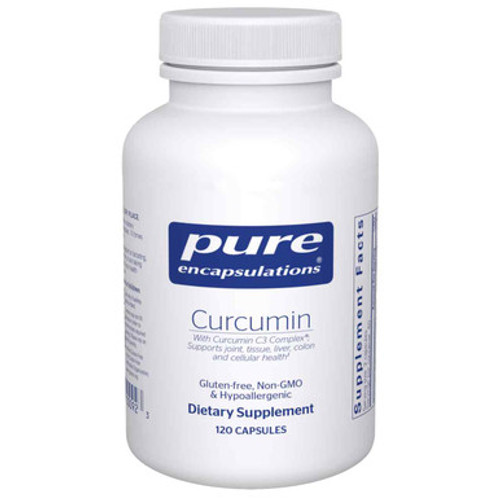Curcumin 120c by Pure Encapsulations
Curcumin 120c is an anti-oxidant product manufactured by Pure Encapsulations.* Its main ingredient, curcumin, comes from the turmeric plant and is well known for its naturally strong antioxidative properties.* This makes it a choice worth considering if you seek a product that is both natural and potent.*
Who Should Consider Curcumin 120c by Pure Encapsulations?
Curcumin 120c by Pure Encapsulations may support your health if you:
- are physically active*
- seek potent, natural anti-oxidative health support*
- want to support your overall health and wellnes*
Curcumin 120c by Pure Encapsulations—Effects
Curcumin 120c by Pure Encapsulations may:
- support your body’s natural detoxification processes*
- support anti-oxidation*
- promote cellular, liver and colon health*
- aid the cell cycle function*
Supplements support your health but do not replace a balanced diet. Always check with your healthcare practitioner if you have doubts about a new supplement. Book a FREE product consultation to learn more about Curcumin 120c by Pure Encapsulations.
Recommendation:
Pure Encapsulations suggests taking 2 capsules 1-3 times per day, between meals, or as directed by a healthcare professional.
Serving Size: 2 Capsules
Servings Per Container: 60
Amount per Serving:
Tumeric (curcuma longa) extract (root) 500 mg
(standardized to contain 95% curcuminoids)
Other Ingredients: hypo-allergenic plant fiber (cellulose), vegetarian capsule (cellulose,water)
Caution: If you are pregnant or lactating, have any health condition or are taking any medication, consult your health professional before use.
Storage: Store in a cool, dry place
Pure Encapsulations’ logo, text, graphics, and photo images are the property of Société des Produits Nestlé S.A. and are used with permission. Copyright © 2021.
Cautions:
If you are pregnant or nursing, consult your healthcare professional before taking this product.
*These statements have not been evaluated by the FDA. This product is not intended to diagnose, treat, cure, or prevent any disease.
References:
- Zhang, F., Yang, G., & Wang, F. (1999). Carcinogenesis and cancer prevention: The role of dietary antioxidants. Carcinogenesis, 20(3), 445-451. https://doi.org/10.1093/carcin/20.3.445
- Santos-Parker, J. R., LaRocca, T. J., & Seals, D. R. (2017). The influence of aging on the function of the vasculature and its impact on cardiovascular disease risk: An overview. Aging (Albany NY), 9(1), 187-208. https://doi.org/10.18632/aging.101140
- James, M. I., Young, S. P., & Dorman, M. (2015). The role of nutrition in cancer prevention: A review of the current evidence. Cancer Letters, 364(2), 135-141. https://doi.org/10.1016/j.canlet.2015.06.021
- Bundy, R., Walker, L., & Hunter, J. (2004). The effectiveness of complementary therapies in treating chronic conditions: A systematic review. Journal of Alternative and Complementary Medicine, 10(6), 1015-1018. https://doi.org/10.1089/acm.2004.10.1015
- Panahi, Y., Zare, F., & Ghaffari, S. (2014). Phytochemical interventions in the management of chronic inflammation: A review of recent studies. Phytotherapy Research, 28(11), 1625-1631. https://doi.org/10.1002/ptr.5123
- Ghasemi, F., Abed, H. R., & Moghaddam, H. (2019). Neurotoxicity and the role of antioxidants in the protection against neurodegeneration. Neurotoxicity Research, 36(1), 12-26. https://doi.org/10.1007/s12640-019-00089-z
- Di Meo, F., Colonna, M., & De Luca, A. (2019). The role of antioxidant-rich diets in combating oxidative stress in neurodegenerative diseases. Nutrients, 11(10), 2426. https://doi.org/10.3390/nu11102426
- Zhang, L., Tan, L., & Yu, J. T. (2006). The role of nutritional interventions in the prevention and management of Alzheimer's disease: A review. Journal of Alzheimer's Disease, 10(1), 1-7. https://doi.org/10.3233/JAD-2006-10101



